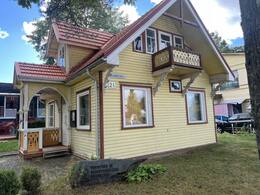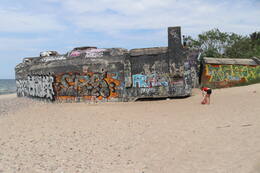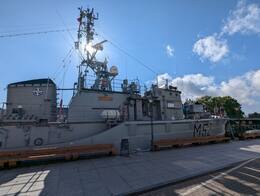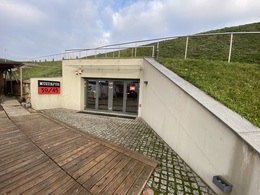Military heritage along the Iron Curtain
Day 1.
120 km
Liepaja - Palanga - Klaipėda
Practical info
- The itinerary is intended as a guide - how to optimally travel a region or country, or two countries, with the aim of getting to know their military heritage;
- The driver must plan for himself - how many of the recommended objects and places he can explore in one day;
- Before traveling, you should check the opening hours of sightseeing places (museums, collections, fortifications, etc.);
- In places where advance registration is required (local guides, private collections, other), a visit must be booked, specifying the date and time. If the trip is canceled, the registered places must be informed;
- Accommodation must be booked in advance. Accommodation may be unavailable during the summer season, especially on the coast. Some catering establishments may not be open during the winter season;
- Choose not only summer for your trip, but also other seasons;
- The Latvian-Lithuanian-Estonian borders can be crossed by road freely without restrictions and at any time of the day. When entering from one country to another, you must have an ID card or passport with you;
- Visit tourist information centers where you can get additional information, brochures, and maps.
Sights
Museum of Exile and Resistance in Palanga
The museum is located in downtown Palanga, in one of the smallest wooden villas of the Palanga resort – Vaidilutė. It was established in 1993, based on the initiative of the Palanga branch of the Lithuanian Union of Political Prisoners and Deportees. The department continues to look after the museum today on a community basis. The volunteers have adapted the villa to the specific needs of the museum and lead the tours themselves.
The exhibition tells the story of the participation of Lithuanians in the resistance movement and the deportations that destroyed people’s lives.
“Memel-Nord” Coastal Artillery Battery
The coastal artillery battery "Memel-Nord" is located in Giruliai, near the Dutch Cap on the Baltic Sea coast.
The coastal artillery battery "Memel-Nord" is an integral part of the German Navy's coastal defense system, which was built in 1939 after the Klaipėda region was annexed to Germany and fortification work began in the city. "Memel-Nord" is an integral part of the Klaipėda city fortifications, consisting of two coastal artillery and six anti-aircraft defense batteries.
The coastal artillery battery was built in two stages, in April and May 1939 a temporary coastal artillery battery was built, and at the end of 1939 a decision was made to expand it and turn it into a permanent position. For this purpose, four artillery gun positions were built in the coastal artillery battery, which were equipped with 150 mm SKL-45 artillery guns, fire control posts and an ammunition depot designed to store 150 units of artillery shells. After these constructions, the battery was given the name Brommy.
The battery consists of three buildings, in the center there is a concrete fire control post, next to it there are two artillery blocks with ammunition storages. Since 2002, an exhibition telling the history of the Klaipėda region has been operating in one of the artillery blocks.
Mine countermeasures ship-museum M52 "Sūduvis"
The M52 “Sūduvis” mine countermeasures ship-museum is located on the Karališkoji Danės waterfront of Klaipėda, next to Castle Bridge.
It is a “Lindau” mine trawler class ship, built in 1956–1958 in West Germany. The mission of these ships is to detect and destroy sea mines. The hull was therefore made of Brazilian oak, the deck of teak, and the machinery, of non-magnetic metal.
From 1958 to 1999, the ship belonged to the German Navy and was named M1071 “Koblenz”. From 1978–1979, it was converted from a mine trawler to a mine hunter.
In 1999, the ship was transferred to the Lithuanian Navy. Navy ships are traditionally named after historical regions of Lithuania, so the received ship was also named M52 “Sūduvis”. The ship served Lithuania for 22 years, taking part in international and national exercises and operations. In 2021, the ship left the service of the Lithuanian Navy and was handed over to the Lithuanian Maritime Museum. Then, 52 “Sūduvis” was opened to the public and adapted for the needs of museum and educational use. The vessel on display has authentic operational equipment.
World War II Exposition “Muziejus 39/45”
“Muziejus 39/45”, which belongs to the History Museum of Lithuania Minor, tells the story of the Second World War events in Klaipėda and the region. The museum is located under a rampart on the eastern side of the former Klaipėda Castle, where German troops had set up an explosives depot during the war.
The exposition of the museum is modern and engaging for visitors: the exposition consists of four halls that present different periods of the wartime, and 13 interactive points have been installed in the halls. The hall “Klaipėda on the Eve of War” displays historical documents and photos, while the radical changes in Europe of the time are described on an original animated map. The hall “The Storming of Klaipėda” reflects the very tragic history of Klaipėda and its inhabitants, while the second hall “Klaipėda after the War” features an installation commemorating the demolished churches of the city. The last one – the Hall of Memories – features a symbolic six-metre-long carriage with a glass roof, under which multiple simple household objects that once belonged to both German soldiers and Klaipėda civilians are on display. The glass is coated with a layer of sand, so you have to brush the sand off with your fingers to see the exhibits.
Places to eat
- In Liepaja, see liepaja.travel
- In Palanga, see visit-palanga.lt
- Restaurant "OLDMAN Palanga", in Palanga
- In Klaipeda, see klaipedatravel.lt
- Restaurant "Pepper Gray", Klaipeda
Places to stay
- In Liepaja, see liepaja.travel
- In Palanga, see visit-palanga.lt
- Hotel "Grand Baltic Dunes", Palanga
- In Klaipeda, see klaipedatravel.lt







